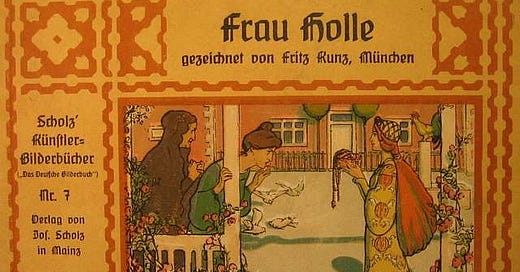Hello, wonderful witches!
It’s the winter solstice — welcome to Yule! How are you planning to celebrate? I’m still waffling on whether I want to get one of the absolutely gorgeous Yule logs from a local bakery, or just make my own. If you have any Yule log traditions, I’d love to hear about them!
I want to take a moment to talk about my book, The Retrograde Guidebook. As of right now, it doesn’t appear to be on any bookshelves in the country because of a break down in publicity. I would be so incredibly appreciative if you would go to your local bookstore and ask for it. Meanwhile, I’m creating a marketing plan to get the word out because as all authors know, no promotion + no visible copies = no sales. Thanks in advance for all of your help!
Today’s piece is about Frau Holle and how she’s celebrated at the solstice.
Getting to Know Frau Holle
By Lisa LaMonica
Frau Holle, also known as Hulda, Old Mother Frost, or Mother Hulda, is known in Germany as the Queen of the Witches and as a winter goddess. In Norse mythology, she gave gifts to women during the winter solstice. She is associated with women’s crafts like spinning and weaving; known as the goddess of hearth, home, and agriculture; and is queen of the forest spirits. She is linked to witchcraft and broom riding.
Frau Holle is associated with Advent and Christmas because she visited the homes of humans giving out treats. Her origin stories pre-date Christianity, though. Her legend includes going from house to house and checking children and spinsters for diligence in spinning. She gave out a punishment if spinning wasn’t completed before the night of her festival, December 25. She is honored throughout time by various winter solstice celebrations and feast days.
Holle is thought to be making her bed when it snows; brushing her beautiful hair when it’s sunny; and cooking when it is foggy outside — all while residing somewhere above the earth. She is known as appearing as a woman from the front and an evergreen tree from behind. She is forever associated with evergreens of the Yule season: holly, bayberry, cedar, wintergreen, wreaths, and trees.
Frau Holle signifies abundance of food and is the Ruler of the Wild Hunt. In olden times, festivals in her name included masked processions or parades depicting wild hunts of boar, rabbit, wolves, bears, foxes, and stags to be feasted on over big roaring fires during the cold months.
It has been said that she, as goddess of agriculture, is the protector of all seeds, which are dormant in the cold months, then awaken to blossom and produce foods in the spring.
Her favorite tree is the elderbush, with its blossoms and berries containing antiviral health properties to help with flu, fever, or a cold. The berries must be cooked, since they’re poisonous when raw.
Some regions of the world have a legend that Frau Holle appears to some as an old woman needing assistance, and if she is given food, she will then reward the kindness in generous fashion. On New Year’s Eve, bowls can be left out to be filled generously with food by Frau Holle. Decent, hardworking people would be rewarded with a pot that always fills with food, such as a boiled or roasted meat every day or an apple tree of their own, bearing much fruit for a long time to come.
Ancient celebrants of Yule ate meals of oat cakes and pickled herring, leaving some out for Frau Holle. Cakes were buried underground and apples were also left out for her. Thick stews and whole grain breads were made to honor her.
The apple tree would be shaken during the start of Yule, with incantations yelled (Little tree, wake up, Frau Holle is coming!) in hopes of producing double the amount of apples in the coming year.
During the Winter Solstice, you can honor her by spinning, knitting, sewing, crocheting, and cooking. One of my favorite aromatic dishes to make during the holiday season is duck, which can be roasted with so many variations.
Duck with Rosemary, Cranberry and Orange Juice
Get a whole duck. (Aldi has been a great source of inexpensive whole duck.) To a roasting pan, add one cup orange juice, one cup water, one acorn squash halved and seeded, and fingerling potatoes.
Rub bacon fat over the entire duck skin, then stick it with sprigs of rosemary. Place the duck in the pan and pour a 16-ounce bag of dried cranberries over it.
Place the pan into a 325°F oven and cook until the duck reaches 180°F internally. The cook time varies depending on the size of the duck. Add more orange juice and water as needed while cooking to prevent the bottom of the pan from becoming dry.
Slice the duck, then pour the pan drippings with cranberry over the meat and roasted vegetables. Serve and enjoy!
Lisa LaMonica is the author of Haunted Catskills and Witches and Warlocks of New York. She has written for Chronogram Magazine, Haunted History Trail of New York/ILoveNY, Hudson Art & History Magazine, Hudson Valley Magazine, and PBS/WMHT. She lives in upstate NY.
In the next issue…
The next newsletter will have… well, I’m not sure yet. We’ll find out together!
See you then!




